INSTITUT SUPERIEUR D'ANTHROPOLOGIE
INSTITUTE OF ANTHROPOLOGY
ONLINE COURSES / COURS A DISTANCE
DEBUT COURS : AVRIL 2023
REGISTER NOW
ITALIE – 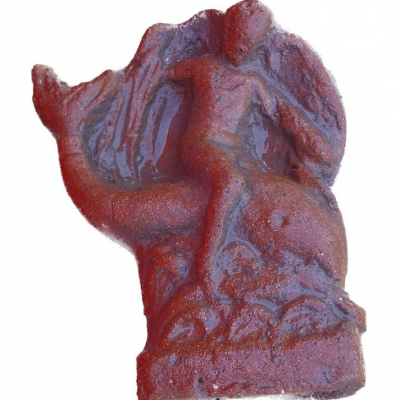
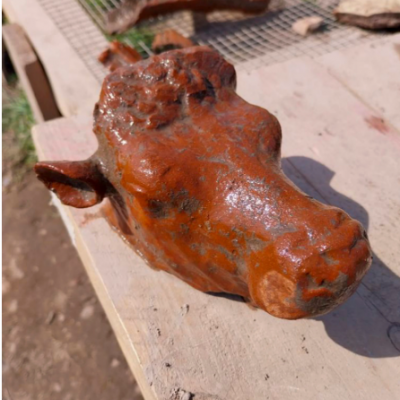 Paestum - Archaeologists have discovered numerous terracotta figurines during excavations in southern Italy that provide insights into religious life in the ancient city of Paestum. In addition to seven bulls’ heads, several miniature temples and altars, representations of the Greek god of love Eros riding a dolphin have been found in the Paestum and Velia Archaeological Park in the Italian province of Salerno. They are “small masterpieces of craftsmanship,” a statement from the archaeological park said on Saturday evening. The finds were made in a small temple discovered by archaeologists in 2019 that dates back to the first decades of the 5th century BC. The discoveries shed a “very interesting light on ancient religious life,” said Massimo Osanna, director general of the state museums. For example, in addition to the figurines and other decorative elements, a stone slab with a kind of gutter was excavated in which – in front of the temple’s altar – liquids such as the blood of sacrificed animals could be collected during religious rites, the park’s director, Tiziana D’Angelo, explained.
Paestum - Archaeologists have discovered numerous terracotta figurines during excavations in southern Italy that provide insights into religious life in the ancient city of Paestum. In addition to seven bulls’ heads, several miniature temples and altars, representations of the Greek god of love Eros riding a dolphin have been found in the Paestum and Velia Archaeological Park in the Italian province of Salerno. They are “small masterpieces of craftsmanship,” a statement from the archaeological park said on Saturday evening. The finds were made in a small temple discovered by archaeologists in 2019 that dates back to the first decades of the 5th century BC. The discoveries shed a “very interesting light on ancient religious life,” said Massimo Osanna, director general of the state museums. For example, in addition to the figurines and other decorative elements, a stone slab with a kind of gutter was excavated in which – in front of the temple’s altar – liquids such as the blood of sacrificed animals could be collected during religious rites, the park’s director, Tiziana D’Angelo, explained.
https://www.scmp.com/news/world/europe/article/3217273/new-finds-italian-archaeological-park-include-greek-god-eros-riding-dolphin
CHINE –  Sanxingcun - Archaeologists will embark on a new excavation at a Neolithic site in eastern China to shed light on the lives of ancient people in the lower reaches of the Yangtze River more than 5,000 years ago. The team is on a mission to unearth the residential and burial areas of the site at Sanxingcun, or Sanxing village, in the coastal province of Jiangsu to reveal its complex social structure, Li Moran, a researcher at the Institute of Archaeology under the Chinese Academy of Social Sciences, told state news agency Xinhua. “The village covered a big area and had a large population. There are significant differences in the number and quality of burial objects and a clear division between residential, handicraft production and burial zones.”The Sanxingcun site dates back 5,500 to 6,500 years and was first excavated from 1993 to 1998, with a focus on its burial sites. It sits at a relatively high elevation and is surrounded by rivers. The new project will cover 800 square metres (8,611 sq ft) of the site, which measures 350,000 square metres in total. More than 4,000 artefacts and animal bones have been unearthed from the site. They include a stone axe decorated to symbolise power and authority and a cup featuring the earliest known example of “cloud and thunder” patterns – a common motif in Neolithic art from China.
Sanxingcun - Archaeologists will embark on a new excavation at a Neolithic site in eastern China to shed light on the lives of ancient people in the lower reaches of the Yangtze River more than 5,000 years ago. The team is on a mission to unearth the residential and burial areas of the site at Sanxingcun, or Sanxing village, in the coastal province of Jiangsu to reveal its complex social structure, Li Moran, a researcher at the Institute of Archaeology under the Chinese Academy of Social Sciences, told state news agency Xinhua. “The village covered a big area and had a large population. There are significant differences in the number and quality of burial objects and a clear division between residential, handicraft production and burial zones.”The Sanxingcun site dates back 5,500 to 6,500 years and was first excavated from 1993 to 1998, with a focus on its burial sites. It sits at a relatively high elevation and is surrounded by rivers. The new project will cover 800 square metres (8,611 sq ft) of the site, which measures 350,000 square metres in total. More than 4,000 artefacts and animal bones have been unearthed from the site. They include a stone axe decorated to symbolise power and authority and a cup featuring the earliest known example of “cloud and thunder” patterns – a common motif in Neolithic art from China.
https://www.scmp.com/news/china/science/article/3217248/archaeologists-china-start-new-hunt-relics-5500-year-old-site
ESPAGNE – 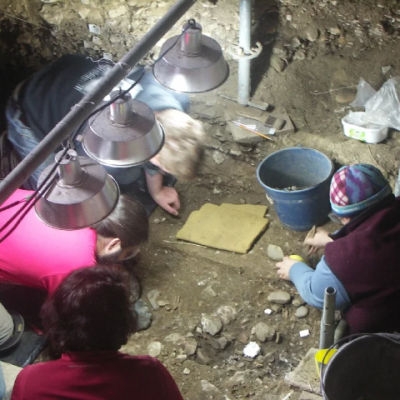 El Mirón Cave - El Mirón Cave is a cave system in the upper Asón River valley, located in the Cantabria region of northern Spain. The cave was first discovered in 1903, leading to a series of excavations over the century revealing evidence of Palaeolithic hunter-gatherer activity, and the discovery of the “Red Lady of El Mirón”, a skeleton from the Upper Palaeolithic which was found coated with ochre, a red iron-based pigment. In a paper published in the journal Antiquity, researchers from the University of New Mexico (UNM) have suggested that a partition made from rocks in the rear of the cave was actually used for bone tool manufacturing around 20,000-years-ago. The cave contains hearths, pits, and other small structures, that provide evidence of Palaeolithic home-making, with the partition indicating that is was used for the working of animal bones and of stones to make tools based on the discarded bone material found around the rock feature. Associate Professor of Archaeology at UNM, Emily Lena Jones, said: “Our hypothesis was that if this feature was used by the inhabitants, the discard around it should show clear patterning. Our analysis showed that this was the case. The stone alignment does seem to have been used in some way, and probably not just to isolate a trash heap. It seems more likely that it is associated with a bone-working area. While probably most of the bones were from animals that initially did provide food for people, by the time the bone fragments were discarded in Level 115 of the cave, they’d also have been broken in ways that suggest people were making tools out of them,” added Jones. According to the researchers, this discovery adds to the small list of known examples of Palaeolithic hunter-gatherer structures in caves, which are often associated with religious or ceremonial activities, but the area in El Mirón looks like it demarcates a working area for a bone tool workshop.
El Mirón Cave - El Mirón Cave is a cave system in the upper Asón River valley, located in the Cantabria region of northern Spain. The cave was first discovered in 1903, leading to a series of excavations over the century revealing evidence of Palaeolithic hunter-gatherer activity, and the discovery of the “Red Lady of El Mirón”, a skeleton from the Upper Palaeolithic which was found coated with ochre, a red iron-based pigment. In a paper published in the journal Antiquity, researchers from the University of New Mexico (UNM) have suggested that a partition made from rocks in the rear of the cave was actually used for bone tool manufacturing around 20,000-years-ago. The cave contains hearths, pits, and other small structures, that provide evidence of Palaeolithic home-making, with the partition indicating that is was used for the working of animal bones and of stones to make tools based on the discarded bone material found around the rock feature. Associate Professor of Archaeology at UNM, Emily Lena Jones, said: “Our hypothesis was that if this feature was used by the inhabitants, the discard around it should show clear patterning. Our analysis showed that this was the case. The stone alignment does seem to have been used in some way, and probably not just to isolate a trash heap. It seems more likely that it is associated with a bone-working area. While probably most of the bones were from animals that initially did provide food for people, by the time the bone fragments were discarded in Level 115 of the cave, they’d also have been broken in ways that suggest people were making tools out of them,” added Jones. According to the researchers, this discovery adds to the small list of known examples of Palaeolithic hunter-gatherer structures in caves, which are often associated with religious or ceremonial activities, but the area in El Mirón looks like it demarcates a working area for a bone tool workshop.
https://www.heritagedaily.com/2023/04/archaeologists-identify-a-palaeolithic-bone-tool-workshop-in-spanish-cave/146948
PORTUGAL –  Constância - While excavating an ancient burial ground at São Julião Church in the tranquil village of Constância, Portugal in 2002, archaeologists dug up the skeleton with this anomalous feature. The large and ugly bone spur had formed on the woman’s femur (upper leg bone), in a location that would have caused her a significant amount of pain. In a new study just published in the International Journal of Paleopathology , a pair of researchers have revealed the truth about this injury. They claim that it was a consequence of a serious muscle injury, specifically to the pectineus muscle that can be found on the upper and inner part of a person’s thigh. The lump of excess bone was alarmingly big, having grown to about three inches (8 cm) in size at the time of the woman’s death. The massive growth was on the woman’s right femur (the left femur was actually missing), right at the spot where the pectineus muscle connects the inner thigh bone to the pubic bone. This is an awkward location, and the presence of the injury and associated bone spur would have made it impossible for the unfortunate woman to move around comfortably. The ill-fated woman was approximately five feet (1.54 m) tall, and over the age of 50 when she passed away. For reasons unknown, she was buried on her back with her hands resting on her hips, with a coin placed on her left forearm and her head bent to the right. The woman’s bones were excavated from what has turned out to be a huge necropolis. So far, the burial sites of 106 adults and 45 children have been discovered at the São Julião Church cemetery, which was used continuously from the 1300s to the 1800s. As of now the researchers involved in this study are uncertain as to when exactly the woman with the bone growth lived and died, although further study of the woman’s skeleton and the site where she was entombed could bring some clarification.
Constância - While excavating an ancient burial ground at São Julião Church in the tranquil village of Constância, Portugal in 2002, archaeologists dug up the skeleton with this anomalous feature. The large and ugly bone spur had formed on the woman’s femur (upper leg bone), in a location that would have caused her a significant amount of pain. In a new study just published in the International Journal of Paleopathology , a pair of researchers have revealed the truth about this injury. They claim that it was a consequence of a serious muscle injury, specifically to the pectineus muscle that can be found on the upper and inner part of a person’s thigh. The lump of excess bone was alarmingly big, having grown to about three inches (8 cm) in size at the time of the woman’s death. The massive growth was on the woman’s right femur (the left femur was actually missing), right at the spot where the pectineus muscle connects the inner thigh bone to the pubic bone. This is an awkward location, and the presence of the injury and associated bone spur would have made it impossible for the unfortunate woman to move around comfortably. The ill-fated woman was approximately five feet (1.54 m) tall, and over the age of 50 when she passed away. For reasons unknown, she was buried on her back with her hands resting on her hips, with a coin placed on her left forearm and her head bent to the right. The woman’s bones were excavated from what has turned out to be a huge necropolis. So far, the burial sites of 106 adults and 45 children have been discovered at the São Julião Church cemetery, which was used continuously from the 1300s to the 1800s. As of now the researchers involved in this study are uncertain as to when exactly the woman with the bone growth lived and died, although further study of the woman’s skeleton and the site where she was entombed could bring some clarification.
https://www.ancient-origins.net/news-history-archaeology/bone-growth-0018256
ANGLETERRE – 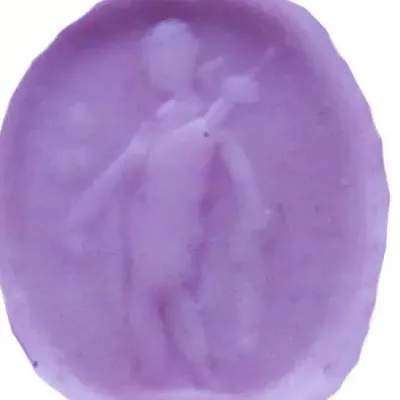 Chelmsford - A metal detectorist found a Roman silver ring in a field near the city of Chelmsford. The ring, which dates to between A.D. 125 and 175, bears an inlaid carnelian carved with an image of the god Apollo that would have been used as a seal to sign documents. "Apollo, being the god of healing and prophecy, would hopefully have protected the wearer from harm or illness," said Essex finds liaison officer Lori Rogerson. Researchers believe the gemstone was produced by the same ancient jewelery workshop that crafted the 110 intaglios of the Snettisham hoard, which was discovered in Norfolk in 1985.
Chelmsford - A metal detectorist found a Roman silver ring in a field near the city of Chelmsford. The ring, which dates to between A.D. 125 and 175, bears an inlaid carnelian carved with an image of the god Apollo that would have been used as a seal to sign documents. "Apollo, being the god of healing and prophecy, would hopefully have protected the wearer from harm or illness," said Essex finds liaison officer Lori Rogerson. Researchers believe the gemstone was produced by the same ancient jewelery workshop that crafted the 110 intaglios of the Snettisham hoard, which was discovered in Norfolk in 1985.
https://www.bbc.com/news/uk-england-essex-65202077
TECHNOLOGIE –
 Conservators and curators from the Art Gallery of New South Wales used the Australian Synchrotron’s advanced imaging technique to learn more about an underpainting in a famous Renaissance portrait of Cosimo I de’ Medici, Grand Duke of Tuscany from 1537 to 1569. The painting, Cosimo I de’ Medici in armour, by Agnolo di Cosimo, known as Bronzino, is one of at least 25 known portraits of the Duke in armour and the only painting by the Italian mannerist painter in an Australian collection. Art Gallery of NSW painting conservators Simon Ives, and Paula Dredge (now at The University of Melbourne) and curator of international art Anne Gérard-Austin, used the X-ray fluorescence (XFM) microscopy instrument to scan the portrait with the assistance of senior instrument scientist Dr. Daryl Howard. Co-author Dr. Howard, who has considerable expertise with investigations of precious works of art, said, “XFM is now an important tool for art historians and museum curators as it can detect and map metals in paint pigments non-invasively.” As reported in an article recently published in the art journal, The Burlington Magazine, most of the metallic elements in pigments can potentially be imaged with the technique. Renaissance artists used expensive paints containing minerals in some parts of their paintings, which can be identified by XFM. The elements mapped by XFM in the painting included mercury (present in the red pigment vermillion, copper (found in azurite), tin (correlated with the use lead tin yellow), iron, (present in a range of ochres) and manganese (in umber) as well as trace elements, notably arsenic, in these pigments derived from mineral deposits. The distribution of elements was mapped across the painting producing single greyscale images that represent the distribution of individual elements. Tonal differences indicate variable concentrations of elements. The existence of a figure under the portrait of Duke Cosimo had been revealed in the early 1980s from an X-ray conducted by American art historian Robert Simon (who later famously discovered Leonardo da Vinci’s Salvator Mundi). The Art Gallery of NSW acquired the Bronzino painting in 1996, but it was still unclear if the figure underneath was an earlier version of the duke. The recent investigation established that the NSW Art Gallery’s portrait of Duke Cosimo was the earliest or ‘prime autograph version’ of the three-quarter length composition, following the primary half-length version of the portrait held in the Uffizi in Florence. The authors also proposed that the image beneath may represent the early thoughts for a painting completed on another panel, Portrait of a young man, now in the Nelson-Atkins Museum in Kansas.
Conservators and curators from the Art Gallery of New South Wales used the Australian Synchrotron’s advanced imaging technique to learn more about an underpainting in a famous Renaissance portrait of Cosimo I de’ Medici, Grand Duke of Tuscany from 1537 to 1569. The painting, Cosimo I de’ Medici in armour, by Agnolo di Cosimo, known as Bronzino, is one of at least 25 known portraits of the Duke in armour and the only painting by the Italian mannerist painter in an Australian collection. Art Gallery of NSW painting conservators Simon Ives, and Paula Dredge (now at The University of Melbourne) and curator of international art Anne Gérard-Austin, used the X-ray fluorescence (XFM) microscopy instrument to scan the portrait with the assistance of senior instrument scientist Dr. Daryl Howard. Co-author Dr. Howard, who has considerable expertise with investigations of precious works of art, said, “XFM is now an important tool for art historians and museum curators as it can detect and map metals in paint pigments non-invasively.” As reported in an article recently published in the art journal, The Burlington Magazine, most of the metallic elements in pigments can potentially be imaged with the technique. Renaissance artists used expensive paints containing minerals in some parts of their paintings, which can be identified by XFM. The elements mapped by XFM in the painting included mercury (present in the red pigment vermillion, copper (found in azurite), tin (correlated with the use lead tin yellow), iron, (present in a range of ochres) and manganese (in umber) as well as trace elements, notably arsenic, in these pigments derived from mineral deposits. The distribution of elements was mapped across the painting producing single greyscale images that represent the distribution of individual elements. Tonal differences indicate variable concentrations of elements. The existence of a figure under the portrait of Duke Cosimo had been revealed in the early 1980s from an X-ray conducted by American art historian Robert Simon (who later famously discovered Leonardo da Vinci’s Salvator Mundi). The Art Gallery of NSW acquired the Bronzino painting in 1996, but it was still unclear if the figure underneath was an earlier version of the duke. The recent investigation established that the NSW Art Gallery’s portrait of Duke Cosimo was the earliest or ‘prime autograph version’ of the three-quarter length composition, following the primary half-length version of the portrait held in the Uffizi in Florence. The authors also proposed that the image beneath may represent the early thoughts for a painting completed on another panel, Portrait of a young man, now in the Nelson-Atkins Museum in Kansas.
https://arkeonews.net/synchrotron-technique-reveals-mysterious-portrait-underneath-renaissance-painting/
ARABIE SAOUDITE – 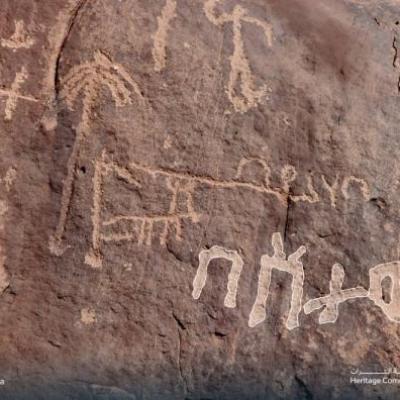
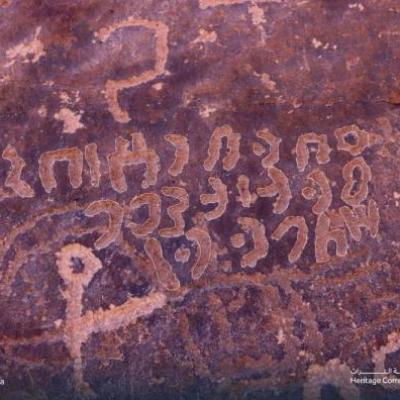 Al-Qassim - Saudi Arabia's Heritage Commission has announced that it has discovered and documented the first two inscriptions written in Dadanitic script in Al-Qassim. The 2 inscriptions highlight the importance of the central region of the Arabian Peninsula as a passage for trade caravans. The Commission's discovery also indicate to the road linking the two Kingdoms of Lihyan and Dadan, which is located in the northwest of the Arabian Peninsula, and the Kingdom of Kinda in Al-Faw, passing through the center of the Arabian Peninsula. It also reflects the civil and commercial communication between the ancient Arab kingdoms of the period before Islam. The two inscriptions come as two commemorative inscriptions, one of which is written by the earlier Dadanitic script, and the other in the late Dadanitic script. The Dadanitic script was found written on the facade of two rocks in an archaeological site called the Al Dulaymiyah site, which is spread in the facade of its southeastern rocks that has several artistic rocks with the forms of many animals such as camels, ostriches and ibex. In addition to the presence of a number of modern artistic rocks of chariots and Arabic Dallah for coffee, as well as ancient Arabic writings including commemorative Thamudic inscriptions, and the two Dadanitic inscriptions. The Commission has found several other discoveries alongside the Dadanitic inscriptions, such as documenting a new archaeological site, which has been named Al Dulaymiyah 3. Al Dulaymiyah 3 is a small sandy mountain, and it has been found in one of its rocks from the southeastern side, a short Thamudic inscription. The Commission has also made preliminary monitoring of 33 stone installation sites in the region, which will be documented later. It is worth mentioning that the Commission aims through the archaeological survey plan in Al-Qassim for the fourth and fifth seasons of 2023-2024 to document all the archaeological monuments in the western and southwestern regions of Al-Qassim, and register them in the National Register of Antiquities. Additionally, the Commission aims to reveal civilizational and cultural implications that reflect the region's richness during the past time periods, as well as to strengthen the role of the local community.
Al-Qassim - Saudi Arabia's Heritage Commission has announced that it has discovered and documented the first two inscriptions written in Dadanitic script in Al-Qassim. The 2 inscriptions highlight the importance of the central region of the Arabian Peninsula as a passage for trade caravans. The Commission's discovery also indicate to the road linking the two Kingdoms of Lihyan and Dadan, which is located in the northwest of the Arabian Peninsula, and the Kingdom of Kinda in Al-Faw, passing through the center of the Arabian Peninsula. It also reflects the civil and commercial communication between the ancient Arab kingdoms of the period before Islam. The two inscriptions come as two commemorative inscriptions, one of which is written by the earlier Dadanitic script, and the other in the late Dadanitic script. The Dadanitic script was found written on the facade of two rocks in an archaeological site called the Al Dulaymiyah site, which is spread in the facade of its southeastern rocks that has several artistic rocks with the forms of many animals such as camels, ostriches and ibex. In addition to the presence of a number of modern artistic rocks of chariots and Arabic Dallah for coffee, as well as ancient Arabic writings including commemorative Thamudic inscriptions, and the two Dadanitic inscriptions. The Commission has found several other discoveries alongside the Dadanitic inscriptions, such as documenting a new archaeological site, which has been named Al Dulaymiyah 3. Al Dulaymiyah 3 is a small sandy mountain, and it has been found in one of its rocks from the southeastern side, a short Thamudic inscription. The Commission has also made preliminary monitoring of 33 stone installation sites in the region, which will be documented later. It is worth mentioning that the Commission aims through the archaeological survey plan in Al-Qassim for the fourth and fifth seasons of 2023-2024 to document all the archaeological monuments in the western and southwestern regions of Al-Qassim, and register them in the National Register of Antiquities. Additionally, the Commission aims to reveal civilizational and cultural implications that reflect the region's richness during the past time periods, as well as to strengthen the role of the local community.
https://saudigazette.com.sa/article/631648/SAUDI-ARABIA/Heritage-Commission-discovers-first-2-Dadanitic-inscriptions-in-Al-Qassim
USA –  Waccamaw - A nearly millennium-old Native American canoe was fished out of a North Carolina lake. The North Carolina Office of State Archaeology and the Waccamaw Siouan Tribe joined forces to pull the 930-year-old canoe out of Lake Waccamaw. Several people were needed to retrieve the enormous 28-foot-long wooden canoe. The boat appeared well-preserved despite deteriorating under the water.
Waccamaw - A nearly millennium-old Native American canoe was fished out of a North Carolina lake. The North Carolina Office of State Archaeology and the Waccamaw Siouan Tribe joined forces to pull the 930-year-old canoe out of Lake Waccamaw. Several people were needed to retrieve the enormous 28-foot-long wooden canoe. The boat appeared well-preserved despite deteriorating under the water.
https://www.foxnews.com/us/north-carolina-archeologists-wiccamaw-siouan-tribe-discover-930-year-old-native-american-canoe-lake
JAPON –  Takaichi - Located in the Takaichi District of Nara Prefecture, Japan, the village of Asuka is famous for its mysterious stones. The ancient origins of the village date back to the Tumulus period, also known as Kofun Jidai (c. 3rd century–538 C.E.). Kofun Jidai period (AD 250–552) is characterized by a specific type of earth mound in the shape of a key and surrounded by moats. However, the area is known for its many Buddhist temples, shrines, and statues. Masuda-no-iwafune (literally “Rock Ship of Masuda”, 益 田 岩 船 in Japanese), or Rock Ship of Masuda, is the name of the largest of these monuments. Its function is still unknown and it is located atop a hill close to Okadera Station. The largest of the mysterious rock mounds, the rock ship is made of solid granite and measures 11 meters (36 feet) by 8 meters (26 feet), 4.5 meters high (15 feet), and weighs approximately 800 tons as it stands. It’s a carved mound, with two holes each about a meter square in the center, going through to the ground. The “rock ship” moniker is most likely due to its canoe-like appearance or location near Lake Masuda. However, as part of regional development, the nearby body of water has been drained. The side of the slope facing the top has been smoothed at a 45-degree angle to the ground. Close to the ground, trellis-shaped chisel marks can be seen on the other three sides. These marks are most likely related to how the builders smoothed the surface of the rock. Because granite is notoriously difficult to carve (even with modern tools), this sculpture captivates experts and scientists who regard it as a technical marvel. Masuda-no-iwafoune’s construction is said to be strikingly similar to that of another Japanese stone enigma, Ishi-no-Hden. Though it is now a shrine dedicated to the Shinto god shiko Jinja, no one knows who carved it or why, though it is thought to have two holes in the center, similar to Masuda-no-iwafune, though they aren’t visible. The most popular theory about the stone’s construction is that it was used as an astronomical observation point. Its orientation alignment with the slope suggests that the monolith may be linked with the Japanese lunar calendar (important for early agriculture) and to the first astronomical observations. However, some experts disagree with this. Other historians contend that the rock designates a royal burial ground, of which only the entrance would have been finished at the time. This still doesn’t explain the unusual features of the structure. With no conclusive information regarding the significance of this enigmatic stone spaceship, the whys, and wherefores of its existence remain a mystery to this day.
Takaichi - Located in the Takaichi District of Nara Prefecture, Japan, the village of Asuka is famous for its mysterious stones. The ancient origins of the village date back to the Tumulus period, also known as Kofun Jidai (c. 3rd century–538 C.E.). Kofun Jidai period (AD 250–552) is characterized by a specific type of earth mound in the shape of a key and surrounded by moats. However, the area is known for its many Buddhist temples, shrines, and statues. Masuda-no-iwafune (literally “Rock Ship of Masuda”, 益 田 岩 船 in Japanese), or Rock Ship of Masuda, is the name of the largest of these monuments. Its function is still unknown and it is located atop a hill close to Okadera Station. The largest of the mysterious rock mounds, the rock ship is made of solid granite and measures 11 meters (36 feet) by 8 meters (26 feet), 4.5 meters high (15 feet), and weighs approximately 800 tons as it stands. It’s a carved mound, with two holes each about a meter square in the center, going through to the ground. The “rock ship” moniker is most likely due to its canoe-like appearance or location near Lake Masuda. However, as part of regional development, the nearby body of water has been drained. The side of the slope facing the top has been smoothed at a 45-degree angle to the ground. Close to the ground, trellis-shaped chisel marks can be seen on the other three sides. These marks are most likely related to how the builders smoothed the surface of the rock. Because granite is notoriously difficult to carve (even with modern tools), this sculpture captivates experts and scientists who regard it as a technical marvel. Masuda-no-iwafoune’s construction is said to be strikingly similar to that of another Japanese stone enigma, Ishi-no-Hden. Though it is now a shrine dedicated to the Shinto god shiko Jinja, no one knows who carved it or why, though it is thought to have two holes in the center, similar to Masuda-no-iwafune, though they aren’t visible. The most popular theory about the stone’s construction is that it was used as an astronomical observation point. Its orientation alignment with the slope suggests that the monolith may be linked with the Japanese lunar calendar (important for early agriculture) and to the first astronomical observations. However, some experts disagree with this. Other historians contend that the rock designates a royal burial ground, of which only the entrance would have been finished at the time. This still doesn’t explain the unusual features of the structure. With no conclusive information regarding the significance of this enigmatic stone spaceship, the whys, and wherefores of its existence remain a mystery to this day.
https://arkeonews.net/rock-ship-of-masuda-japans-mysterious-monolith/